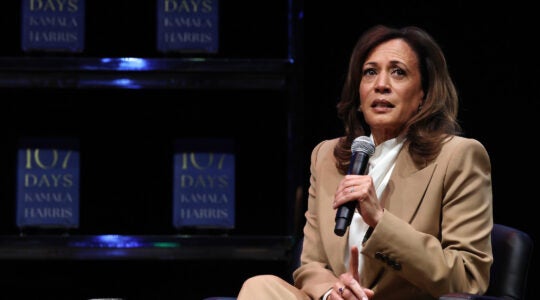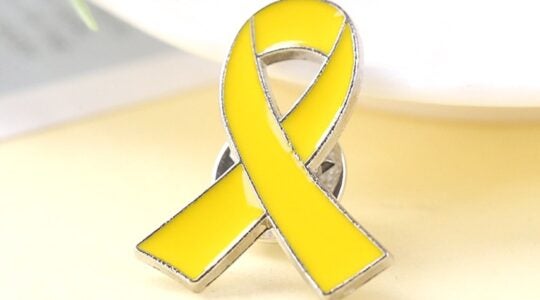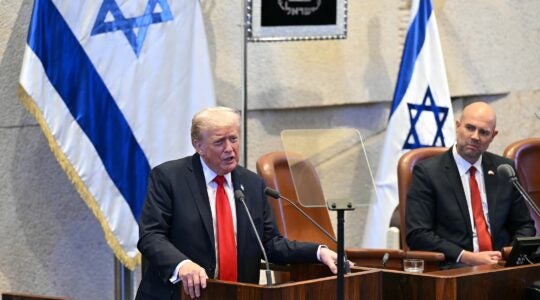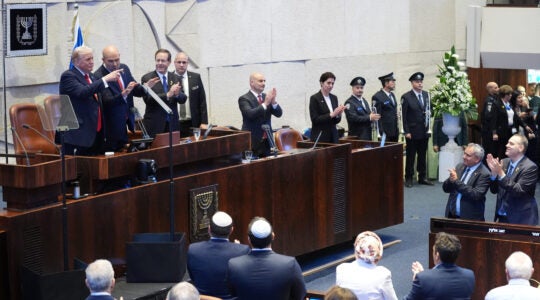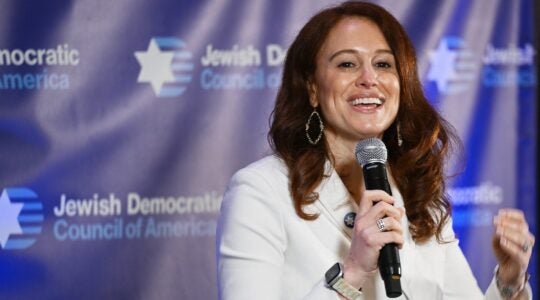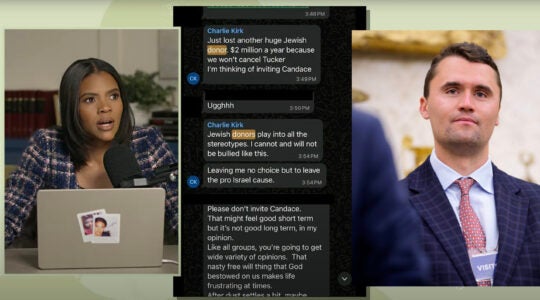NEW YORK (JTA) – On a gray afternoon in early February, some 20 members of the Altshul, a lay-led minyan in Brooklyn, gathered to discuss congregants’ objections to the community’s recitation of the prayer for the State of Israel.
The minyan, which is egalitarian but otherwise hews to a traditional liturgy, had recited the prayer since its founding in 2005. But some members had begun to express misgivings about the prayer, which describes Israel as the “first flowering of the redemption” and asks God to deliver to Israel’s military forces victory over their enemies.
Congregants at the meeting also challenged the prayer’s conflation of religion and politics, its tone of Jewish triumphalism and exclusivity, and its seeming denigration of Diaspora Jewry.
“Expecting everyone to stand and recite, in unison, something so political clearly sends a message: If you don’t identify with the vision of Israel that is expressed in this prayer, then you are wrong,” Alana Alpert, the Altshul member who initiated the meeting, told JTA. “The prayer is just one more way that American Jews are given a litmus test on their Israel politics, determining who is inside and who is outside the Jewish community.”
First published by Israel’s Chief Rabbinate shortly after the founding of the state 60 years ago – some credit Israeli Nobel laureate S.Y. Agnon with actual authorship – the prayer is recited in the vast majority of American synagogues. But in recent years, a number of communities have begun to question its place in the liturgy.
At the Shtibl Minyan in Los Angeles, an egalitarian group that, like the Altshul, mostly follows traditional liturgy, the prayer was dropped when the community formed in 2000; it later was reinstated in a revised form at the urging of some members. A number of other communities have changed the prayer to bring it more in line with local sensibilities.
Alpert says the prayer should account for the consequences of Israel’s creation for the land’s other inhabitants. At the February meeting, she cited a Jewish legend that describes how God reprimanded the angels for celebrating along with the Israelites as the Egyptians were drowning in the Red Sea.
“Why do the Israelites get to rejoice and the angels do not? The angels have perspective – they can see implications and consequences,” Alpert told JTA. “I would like to think that we can be more like the angels. I feel such triumphalism in the face of the conflict in Israel and Palestine is irresponsible.”
“Strengthen the hands of those who defend our holy land, grant them deliverance, and adorn them in a mantle of victory,” reads the Israel prayer. “Ordain peace in the land and grant its inhabitants eternal happiness. Lead them, swiftly and upright, to Your city Zion and to Jerusalem, the abode of Your Name.”
Aviva Bock, a member of the Newton Centre Minyan, another traditional egalitarian community, says there is something problematic about simply reciting this formula.
“The prayer should be a reflection of our hopes and prayers in the context of today rather than something that feels to me like it was written at a very different moment in time,” said Bock, who teaches psychotherapy at Harvard University.
The Newton Centre Minyan is presently grappling with a similar issue, the prayer for the United States government. Bock says she may raise her problems with the Israel prayer too.
Of all the objections to the prayer, the declaration that Israel’s founding heralds the dawn of the messianic age is the passage deemed most problematic across Jewish denominations.
Fervently Orthodox, or haredi, Jews, have long eschewed the prayer – most of them because of its messianic component, but a minority because of their principled opposition to the state. That minority believes the restoration of Jewish sovereignty must await the coming of the Messiah.
“I think the essential problem with it from a haredi viewpoint is it seems to project the establishment of the State of Israel as a monumental movement forward towards the ultimate redemption of the Jewish people,” said Rabbi Avi Shafran, the public affairs director for the fervently Orthodox Agudath Israel of America. “While we may hope that it might play that role, by no means is that self evident.”
At the Altshul, remedies proposed for the Israel prayer included eliminating it to cutting its most controversial passages. Some communities have supplemented the prayer with other readings, like passages from Israel’s Declaration of Independence or Israeli folk songs.
At the Shtibl Minyan, a sort of hybrid solution was reached: Worshipers can recite no prayer or one of several alternatives, including one authored by one of the minyan’s founders, Aryeh Cohen, a professor of rabbinic literature at the American Jewish University. His prayer describes Israel as cause for “tears and jubilation, celebration and grief,” according to a translation from the Hebrew.
“It’s actually a moment of religious cacophony,” said Cohen, who lived in Israel for 12 years and served in its army. “Everybody says the prayer that they want to say.”
Among the established denominations, some version of the prayer remains in widespread use. Both the Reform and Conservative prayer books include it in a truncated form, eliminating certain passages both for reasons of length and because they speak of the ingathering of the exiles – a notion that some consider insulting to non-Israeli Jews.
The main edition of the ArtScroll siddur, the most common Orthodox text, does not include the prayer, but a special edition published by the Rabbinical Council of America does.
Rabbi Jeremy Kalmanofsky, who leads the Conservative congregation Anshe Chesed in Manhattan, told JTA some “tweaks” were made to his synagogue’s version of the prayer as a byproduct of a larger discussion about prayers with nationalistic overtones.
Kalmanofsky himself recommended an alteration of the passage that speaks of Israeli soldiers achieving “victory,” substituting instead a verse from Isaiah asking that they return in peace.
“We’re not neutral here. We certainly hope that the Israeli state thrives,” Kalmanofsky said. “But certain formulations in Siddur Sim Shalom” – the standard Conservative text – “were not entirely satisfactory. We wanted something a bit less militaristic and that prayed for peace for the Palestinians, too.”
At Manhattan’s Jewish Center, a modern Orthodox shul, the congregation for many years had substituted an alternate version of the Israel prayer due to discomfort over the messianic element in the line characterizing Israel as “the first flowering of the redemption.”
But Rabbi Jacob Schacter reinstated the original version when he arrived at the shul in 1981. Schacter, who is now the senior scholar at Yeshiva University’s Center for the Jewish Future, said the passage about the redemption is the prayer’s most important part.
“I feel that, ideologically, the key phrase, and the one that elicits the most reaction, is ‘reishit tz’michat g’eulateinu,” Schacter said, referring to the passage in the original Hebrew. “And I feel very strongly that it’s absolutely appropriate for that phrase to be included.”
While a number of prayers may be offensive to modern sensibilities, the Israel prayer’s political overtones make it both particularly hard for many Jews – and especially ripe for modification, some say.
“It has a little less of the longstanding authenticity that the rest of the siddur may claim,” said Rabbi Elie Kaunfer, who led a study session about the prayer’s history at the Altshul meeting.
“Therefore, when you have an issue with the prayer, if you knew the person who wrote it and you knew the circumstances under which it was written, you are more tempted to say this is something that I can rewrite.”
JTA has documented Jewish history in real-time for over a century. Keep our journalism strong by joining us in supporting independent, award-winning reporting.
